IGUANAS
 ब्लू गोधा |  सूरजमुखी मनुष्य गोधा |
|---|---|
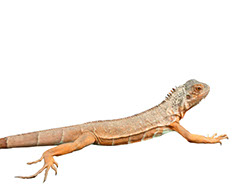 लाल गोधा | 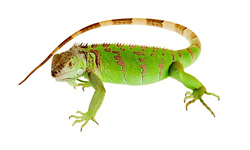 हरी गोधा |
गोधा केयर शीट
आकार: वयस्क iguanas चार में लंबाई छह फुट से से आकार में सीमा.
जीवन काल: यदि ठीक से देखभाल के लिए, iguanas अधिक से अधिक 20 साल कैद में रहते हैं चाहिए.
सामान्य सूरत: Iguanas हैं क्या जब वे \'छिपकली.\' लगता है के अधिकांश लोगों को लगता है वे प्रत्येक पैर पर पैर की उंगलियों है। वे एक मांसल प्रालंब नामक एक dewlap ठोड़ी के नीचे त्वचा के अधिकारी। सभी iguanas कि पीछे की लंबाई चला कर देते हैं। लोकप्रिय धारणा के विपरीत, नहीं सभी iguanas हरे हैं। अधिकांश juveniles चमकीले हरे, कर रहे हैं लेकिन वे उम्र और वे बढ़ने के रूप में धारीदार मासा के साथ भूरे रंग या यहां तक कि ऑरेंज के लिए एक सुस्त हरे रंग से रंग में रेंज कर सकते हैं.
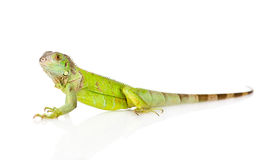
आवास की आवश्यकताओं
बाड़े: बाड़े एक वयस्क गोधा के लिए बहुत बड़ी है। बाड़े में कम से कम छह फुट लंबा, लगभग 1½ गोधा, और 2\\/3 करने के लिए एक विस्तृत गोधा की पूरी लंबाई का दो बार लंबाई करने के लिए होना चाहिए। एक छह फुट वयस्क गोधा के लिए यह एक दीवार है कि 9 से 12 फीट लंबी, चार से छह फुट चौड़ी है, और कम से कम छह फुट लंबा है। पर्याप्त शाखाओं और अलमारियों चढ़ाई और lounging के लिए भी प्रदान की जानी चाहिए। तुम बाड़े के आकार पर परिप्रेक्ष्य देने के लिए, सबसे छोटे बेडरूम केवल 9 फुट चौड़े हैं। इस कारण कई मालिकों उनके \'गोधा कमरे।\' के रूप में एक अलग कमरा समर्पित है कुछ मालिकों भी घर भर में उनके iguanas \'नि: शुल्क रेंज\' के लिए अनुमति देते हैं। अगर तुम अपने कमरे या नि: शुल्क रेंज, में रहने के लिए अपने गोधा ज़रूर रखें जा गोधा अक्सर करेंगे क्षेत्र की अनुमति की छोटी वस्तुओं है कि गोधा अकस्मात निगलना हो सकता मुक्त।
तापमान: Iguanas आने से एक उष्णकटिबंधीय जलवायु और गर्म रखा जा करने की आवश्यकता है। दिन के समय तापमान एक basking स्पॉट के 90 ° - 95 ° एफ के साथ 80 ° - 85 ° F होना चाहिए तापमान गोधा के लिए इसे ही thermoregulate करने के लिए अनुमति देने के लिए की पेशकश की एक सीमा होनी चाहिए। Nighttime तापमान 75 ° - 80 ° एफ होना चाहिए सभी तापमान एक थर्मामीटर के साथ नियमित रूप से सत्यापित किया जाना चाहिए.
हीट लाइट: पराबैंगनी प्रकाश व्यवस्था प्रदान करने के UVA और UVB उचित कैल्शियम चयापचय और कंकाल के विकास के लिए आवश्यक है। उचित प्रकाश तुम्हारी इच्छा के बिना बीमार हो गया और एक बहुत ही दर्दनाक मौत मर जाते हैं। उपयोग फ्लोरिसेंट ट्यूब के लिए विशेष रूप से किए सरीसृप के रूप में अच्छी तरह के रूप में द्वारा पारा वाष्प बल्ब है कि भी उपलब्ध कराने के रूप में अच्छी तरह से कुछ गर्मी का प्रयोग समुचित प्रकाश व्यवस्था प्रदान की जा सकती। अवरक्त सिरेमिक emitters और तापदीप्त बल्बों basking का उपयोग अतिरिक्त गर्मी प्रदान की जा सकती। वे गंभीर रूप से अपने गोधा को जला कर सकते हैं के रूप में गर्म चट्टानों कभी नहीं किसी भी परिस्थिति के तहत इस्तेमाल किया जाना चाहिए.

सब्सट्रेट: Iguanas अपने आसपास अक्सर जीभ चाटना होगा। इस कारण सबसे अधिक कण सब्सट्रेट (लकड़ी शेविंग्स, गीली घास, रेत या पाउडर प्रकार) ज्यादातर iguanas के लिए उपयुक्त नहीं हैं। अखबार गैर विषैले स्याही, कसाई कागज, पेपर टॉवेल, इनडोर\\/आउटडोर गलीचे से ढंकना, या कृत्रिम घास सब के साथ बहुत बढ़िया विकल्प बना। यदि इनडोर\\/आउटडोर गलीचे से ढंकना या कृत्रिम घास का उपयोग कर कृपया यकीन है कि वहाँ कोई dangling तार कि आपके गोधा नाखूनों में विवाद कर सकते हैं होना। यह भी अनुशंसित है कि आप एकाधिक टुकड़े है इतना है कि आप हो सकता साफ सेट के साथ गंदे के टुकड़े की जगह और फिर स्वच्छ और अगले सफाई के लिए उपयोग करने के लिए मौजूदा सेट कीटाणुरहित.
Environment: Iguanas come from a tropical climate and require a humidity level of 65% to 75%. To achieve this may require several misting’s a day. Many people opt to purchase an automatic misting system instead.
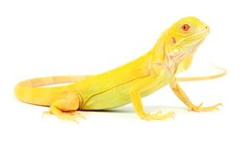
Diet: Iguanas are strict herbivores. Many older literatures will suggest feeding animal protein or even cat food. While some wild iguanas may ingest the occasional insect while eating leaves, it is not a significant portion on their diet. Iguanas that are fed too much animal protein will develop health problems and will die prematurely. A well balanced iguana diet will consist of about 40% to 45% greens (this includes, but is not limited to collard greens, turnip greens, mustard greens, dandelion greens (with flowers), escarole, and/or water cress), 40% to 45% other vegetables (this includes but is not limited to green beans, orange-fleshed squashes (butternut, Kabocha), snap or snow peas, parsnip, asparagus, okra, alfalfa (mature, not sprouts), onions, mushrooms, bell peppers, sweet potato, zucchini, yellow squash, and/or carrots), 10% or less of fruits (including, but not limited to Figs (raw or dried), blackberries, strawberries, raspberries, grapes, mango, melon (cantaloupe, honeydew, watermelon), papaya, banana, and/or apple), and less than 5% of other grains or commercial diets. Iguanas should never be rhubarb as it is toxic. Certain lettuces such as iceberg, romaine, and Boston butter lack sufficient nutrients and should only be fed occasionally. Acidic fruits (citrus, tomatoes, kiwi, pineapples, etc.) should also be only fed occasionally as well. Tofu can be occasionally offered as well for supplemental protein, though if too much is given it can lead to long term health issues. Wild plants and flowers are not recommended since they may be toxic to your iguana or may contain pesticides that could be toxic as well.
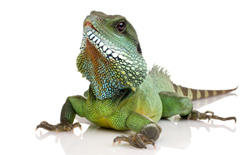
Maintenance: Cleanliness of the enclosure is essential. Waste products should be removed daily and the enclosure should be thoroughly cleaned and disinfected regularly. A 5% bleach solution provides an excellent disinfectant. Be sure to thoroughly rinse the solution from the enclosure before placing the iguana back in. Fresh water should also be offered at all times. Always wash your hands after handling your iguana or any of your iguana\'s cage accessories.